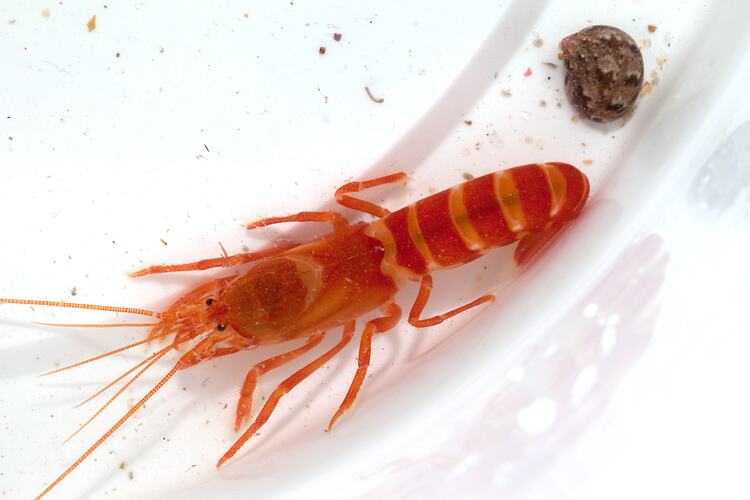General Description
Compact, shrimp-like body, large claws more or less the same size, sparsely setose. Spiny triangular rostrum (protrusion of carapace) over the eyes. Carapace smooth, eyes pigmented. Telson (posterior-most segment) without lateral teeth. Abdominal segments 2-5 rounded ventrally. Up to 2.5 cm long.
Biology
Mud shrimps build permanent burrows in firm sediment. Some large species, and there are many in the tropics, burrow up to three metres deep. Axiids have a compact, shrimp-like body, large claws more or less the same size, and oval branches of the uropod (paired appendage of the tail fan) with a joint across the end of the outer branch. Most have a spiny triangular rostrum over the eyes. Like all thalassinideans, the last legs appear disconnected from the ventral plate to which all the other legs attach.
Distribution
Southern Australia.
Habitat
Intertidal areas in mud, to depth of 27 m.
More Information
-
Animal Type
-
Animal SubType
-
Brief Id
Compact, shrimp-like body, large claws more or less the same size, spiny triangular rostrum over the eyes.
-
Maximum Size
2.5 cm
-
Habitats
-
Diet
Carnivore
-
Diet Categories
Animal matter
-
Hazards
Small claws but unlikely to nip.
-
Endemicity
-
Commercial
No
-
Conservation Statuses
DSE Advisory List: Not listed, EPBC Act 1999: Not listed, IUCN Red List: Not listed
-
Depths
Shore (0-1 m), Shallow (1-30 m)
-
Water Column Locations
On or near seafloor
-
Taxon Name
-
Scientific Author
(De Man, 1925)
-
Common Name
Mud Shrimp
-
Phylum
-
Subphylum
-
Superclass
-
Class
-
Subclass
-
Superorder
-
Order
-
Suborder
-
Infraorder
-
Family
-
Genus
-
Species Name
australiensis

